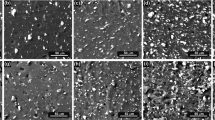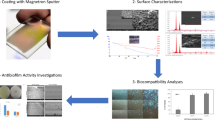Abstract
Biofilm formation, also known as microfouling, on indwelling medical devices such as catheters or prosthetic joints causes difficult to treat and recurrent infections. It is also the initial step for biocorrosion of surfaces in aquatic environment. An efficient prevention of microfouling is preferable but the development of antibiofilm surfaces is enormously challenging. Therefore, soda-lime, aluminosilicate, and three borosilicate glasses with different TiO2 and ZnO compositions were investigated on their feasibility to prevent biofilm formation by standardized in vitro biofilm assays using different pathogenic bacteria. Furthermore, the biocompatibility of these glasses was evaluated using eukaryotic cell lines end erythrocytes. Only two borosilicate glasses, containing TiO2 and ZnO, showed an increased antibiofilm performance inhibiting biofilm adhesion and formation. The biofilm thickness and area were significantly reduced by over 90 % and characterized by diffuse structures. All tested glass types showed neither cytotoxicity nor hemotoxicity. Therefore, the antibiofilm borosilicate-thin glasses are qualified for surface coatings where biofilms are not desirable such as on medical devices.


Similar content being viewed by others
References
Stoodley P, Sauer K, Davies DG, Costerton JW. Biofilms as complex differentiated communities. Annu Rev Microbiol. 2002;56:187–209. doi:10.1146/annurev.micro.56.012302.160705.
Callow ME, Callow JE. Marine biofouling: a sticky problem. Biologist. 2002;49(1):10–4.
Flemming H-C. Microbial biofouling: unsolved problems, insufficient approaches, and possible solutions. Biofilm highlights. Springer-Verlag Berlin Heidelberg; 2011. pp. 81–109.
Donlan RM. Biofilms and device-associated infections. Emerg Infect Dis. 2001;7(2):277–81. doi:10.3201/eid0702.700277.
Langmark J, Storey MV, Ashbolt NJ, Stenstrom TA. Biofilms in an urban water distribution system: measurement of biofilm biomass, pathogens and pathogen persistence within the Greater Stockholm Area, Sweden. Water Sci Technol. 2005;52(8):181–9.
Bridier A, Briandet R, Thomas V, Dubois-Brissonnet F. Resistance of bacterial biofilms to disinfectants: a review. Biofouling. 2011;27(9):1017–32. doi:10.1080/08927014.2011.626899.
Ito A, Taniuchi A, May T, Kawata K, Okabe S. Increased antibiotic resistance of Escherichia coli in mature biofilms. Appl Environ Microbiol. 2009;75(12):4093–100. doi:AEM.02949-08 [pii] 10.1128/AEM.02949-08.
Burmolle M, Webb JS, Rao D, Hansen LH, Sorensen SJ, Kjelleberg S. Enhanced biofilm formation and increased resistance to antimicrobial agents and bacterial invasion are caused by synergistic interactions in multispecies biofilms. Appl Environ Microbiol. 2006;72(6):3916–23. doi:72/6/3916 [pii] 10.1128/AEM.03022-05.
Leid JG. Bacterial biofilms resist key host defenses. Microbe. 2009;4(2):66–70.
Fux C, Costerton J, Stewart P, Stoodley P. Survival strategies of infectious biofilms. Trends Microbiol. 2005;13(1):34–40.
Agarwal A, Singh KP, Jain A. Medical significance and management of staphylococcal biofilm. FEMS Immunol Med Microbiol. 2010;58(2):147–60. doi:FIM601 [pii] 10.1111/j.1574-695X.2009.00601.x.
Maki DG, Kluger DM, Crnich CJ. The risk of bloodstream infection in adults with different intravascular devices: a systematic review of 200 published prospective studies. Mayo Clinic proceedings. 2006;81(9):1159–71. doi:10.4065/81.9.1159.
Uckay I, Pittet D, Vaudaux P, Sax H, Lew D, Waldvogel F. Foreign body infections due to Staphylococcus epidermidis. Ann Med. 2009;41(2):109–19. doi:10.1080/07853890802337045.
Chen M, Yu Q, Sun H. Novel strategies for the prevention and treatment of biofilm related infections. Int J Mol Sci. 2013;14(9):18488–501. doi:ijms140918488 [pii] 10.3390/ijms140918488.
Hetrick EM, Schoenfisch MH. Reducing implant-related infections: active release strategies. Chem Soc Rev. 2006;35(9):780–9.
Klueh U, Wagner V, Kelly S, Johnson A, Bryers J. Efficacy of silver‐coated fabric to prevent bacterial colonization and subsequent device‐based biofilm formation. J Biomed Mater Res. 2000;53(6):621–31.
McLean RJ, Hussain A, Sayer M, Vincent PJ, Hughes DJ, Smith TJ. Antibacterial activity of multilayer silver-copper surface films on catheter material. Can J Microbiol. 1993;39(9):895–9.
Gottenbos B, van der Mei HC, Klatter F, Nieuwenhuis P, Busscher HJ. In vitro and in vivo antimicrobial activity of covalently coupled quaternary ammonium silane coatings on silicone rubber. Biomaterials. 2002;23(6):1417–23.
Park KD, Kim YS, Han DK, Kim YH, Lee EHB, Suh H, et al. Bacterial adhesion on PEG modified polyurethane surfaces. Biomaterials. 1998;19(7–9):851–9. doi:10.1016/S0142-9612(97)00245-7.
Costa F, Carvalho IF, Montelaro RC, Gomes P, Martins MCL. Covalent immobilization of antimicrobial peptides (AMPs) onto biomaterial surfaces. Acta Biomater. 2011;7(4):1431–40. doi:10.1016/j.actbio.2010.11.005.
Genzer J, Efimenko K. Recent developments in superhydrophobic surfaces and their relevance to marine fouling: a review. Biofouling. 2006;22(5):339–60.
Stollberg D, Carter W, Hampikian JM. Nanohardness and fracture toughness of combustion chemical vapor deposition deposited yittria stabilized zirconia–alumina films. Thin Solid Films. 2005;483(1):211–7.
Ericsson M, Hanstorp D, Hagberg P, Enger J, Nystrom T. Sorting out bacterial viability with optical tweezers. J Bacteriol. 2000;182(19):5551–5.
Schmidt C, Lautenschlaeger C, Collnot EM, Schumann M, Bojarski C, Schulzke JD, et al. Nano- and microscaled particles for drug targeting to inflamed intestinal mucosa: a first in vivo study in human patients. J Control Release. 2013;165(2):139–45. doi:10.1016/j.jconrel.2012.10.019.
Bauer M, Lautenschlaeger C, Kempe K, Tauhardt L, Schubert US, Fischer D. Poly(2-ethyl-2-oxazoline) as alternative for the stealth polymer poly(ethylene glycol): comparison of in vitro cytotoxicity and hemocompatibility. Macromol Biosci. 2012;12(7):986–98. doi:10.1002/mabi.201200017.
Park JT, Uehara T. How bacteria consume their own exoskeletons (turnover and recycling of cell wall peptidoglycan). Microbiol Mol Biol Rev. 2008;72(2):211–27.
Monteiro C, Fang X, Ahmad I, Gomelsky M, Römling U. Regulation of biofilm components in Salmonella enterica serovar Typhimurium by lytic transglycosylases involved in cell wall turnover. J Bacteriol. 2011;193(23):6443–51.
Lansdown AB, Mirastschijski U, Stubbs N, Scanlon E, Ågren MS. Zinc in wound healing: theoretical, experimental, and clinical aspects. Wound Repair Regen. 2007;15(1):2–16.
Fujishima A, Rao TN, Tryk DA. Titanium dioxide photocatalysis. J Photochem Photobio C. 2000;1(1):1–21. doi:10.1016/S1389-5567(00)00002-2.
Parvizi J, Wickstrom E, Zeiger AR, Adams CS, Shapiro IM, Purtill JJ, et al. Frank Stinchfield Award: titanium surface with biologic activity against infection. Clin Orthop Relat Res. 2004;429:33–8.
Long M, Rack HJ. Titanium alloys in total joint replacement—a materials science perspective. Biomaterials. 1998;19(18):1621–39.
Freedman LD, Doak G, Long GG, Mahmood T, Lindhal CB. Antimony compounds. Kirk-Othmer Encyclopedia of Chemical Technology. 2007.
Mahajan K, Fahmi N, Singh RV. Synthesis, characterization and antimicrobial studies of Sb (III) complexes of substituted thioimines. Indian J Chem. 2007;46:1221–5.
Acknowledgments
The authors thank the Department of Research and Technology Development of SCHOTT AG (Mainz) for the collaboration and for provision of the glass slides. This work was supported by a grant from the Federal Ministry of Education and Research (Germany), grant numbers 01EO1002.
Author information
Authors and Affiliations
Corresponding author
Ethics declarations
Conflict of interest
The authors declare that they have no competing interests.
Electronic supplementary material
Rights and permissions
About this article
Cite this article
Klinger-Strobel, M., Makarewicz, O., Pletz, M.W. et al. TiO2-containing and ZnO-containing borosilicate glass—a novel thin glass with exceptional antibiofilm performances to prevent microfouling. J Mater Sci: Mater Med 27, 175 (2016). https://doi.org/10.1007/s10856-016-5792-4
Received:
Accepted:
Published:
DOI: https://doi.org/10.1007/s10856-016-5792-4




